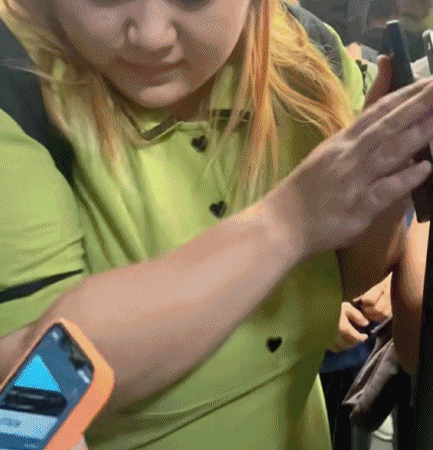
For China’s Plus-Size Women, Going Out Is a Daily Struggle
Weighing 315 pounds, 27-year-old Fu Tuntun’s life so far has been full of embarrassing moments, including setting off an elevator’s overcapacity warning when it was largely empty, getting stuck at a metro ticket barrier, and being asked whether she was pregnant at a job interview.
Although inroads have been made in domains such as fashion and entertainment in terms of representation of plus-size people in China, experiences like Fu’s are still common. Even as cultural attitudes towards body weight and shapes are slowly changing, many plus-size people are still finding it difficult to navigate a physical environment designed for slimmer people.
A social media influencer, Fu has been sharing videos documenting her daily life since July. She has launched a series of videos showing her taking on “100 challenges for plus-size girls.” In October, one of these videos went viral, showing her taking a high-speed train from Guangzhou in southern China to another city.

This was Fu’s first time taking a high-speed train in several years. She told Sixth Tone that she has always been nervous about taking public transport due to her size, and she has never left Guangdong province, let alone been on a plane.
“I believe there are a lot of plus-size people out there besides me. I may not be able to contact them directly, but they can watch my videos on their phones at home. And maybe if I go out, they will be encouraged to do so too,” Fu said, using her internet pseudonym for privacy reasons.
On the train, where each row has three seats, Fu chose to sit in the window seat, leaving a space between herself and the passenger in the aisle seat. But Fu still found it difficult to squeeze her way to the innermost seat, where there was little room to move once she sat down and the small tray dug into her when lowered.
On the return leg, Fu bought a first-class ticket for the 24-minute ride instead, which was 20 yuan ($2.81) more expensive but gave her more room. For longer distances, such as the high-speed train between Beijing and Shanghai, first-class tickets can cost up to 1.6 times more than second-class tickets.
The video, which ends with Fu describing the life of a plus-size person as “too difficult,” elicited some sympathy among netizens. “I think we should not discriminate against people and respect every body type,” a woman surnamed Peng told domestic media. But many users also left derogatory comments, accusing her of causing her own misery.

With a BMI of 49.4, Fu is considered obese under China’s official standards. A large-scale study of 15.8 million Chinese adults last year found that 48.9% were overweight or obese.
However, space in China’s public transport has not been increasing. Individual seats on China’s high-speed trains are 430 or 435 millimeters wide for second-class seats and 475 millimeters wide for first-class seats.
The dimensions were determined based on official measurements of Chinese people’s physical proportions made in 1988. Nonetheless, researchers noted in 2018 that the dimensions still met the needs of the vast majority of people.
Though China is set to update its official dimensions for Chinese adults, there have been no announcements so far of train seats being expanded. Plus-size people like Fu also cannot resort to buying more space, as China Railway limits passengers to buying one ticket per ID card.
In Fu’s video, she was able to buy two tickets for the middle and window seats because her friend was also traveling with her. A customer service agent for China Railway told Sixth Tone that plus-size people should consider the more expensive first-class or business seats if they want a more comfortable experience.
“I’m just an ordinary person and have never considered asking the high-speed rail department to make changes for me. It would be better if we could buy extra seats, but if not, we will try to buy first-class seats to solve the issue,” said Fu.
Staff at China Southern Airlines, one of China’s biggest airlines, told Sixth Tone that travelers can choose to buy two adjacent seats, but various airports may not permit this due to safety concerns. Some foreign airlines have introduced special policies for plus-size travelers, including providing extra seats for free.
Pan Yuxin, a 28-year-old plus-size woman weighing 190 pounds, does not believe such plus-size-specific policies are necessary, however. Instead of special treatment, she just wants to see the width of seats on Chinese public transport increased: “The current seat dimensions are just inherently narrow, it’s not a weight issue.”
Some public transport systems in the country have already noticed the need for improved seating. For example, some bus routes in the eastern cities of Shanghai and Nanjing have introduced wider seats and removed demarcations of single seating spaces. Though the changes were billed as being catered to mothers and people with disabilities, the new seats are also wide enough for plus-size people.

For Pan, based in Shanghai, life as a plus-size woman has never been easy. But in recent years, shopping for clothes has become more convenient as online shopping has exploded. The emergence of plus-size clothing stores and models has created a market estimated to be worth around $4.8 billion in 2019, according to a report from Coresight Research.
A search for plus-size women’s clothing on e-commerce platform Taobao shows more than 410,000 related stores. Plusmall, a top plus-size brand, saw sales of more than 50 million yuan during an online shopping festival last June.
However, Pan believes there is still room for improvement in China’s attitudes towards plus-size people. Part of the problem is that the country has yet to see a “body positivity” or “size inclusivity” trend that challenges prevailing attitudes. Discussions in online forums for plus-size people are mainly for sharing dating contacts and providing fashion advice.

“I still cannot find models with a similar figure to mine so as to get an idea of how clothes would look,” Pan told Sixth Tone.
Like Fu, Pan is also constantly attacked by netizens when she shares her struggles as a plus-size person on Xiaohongshu, a lifestyle platform. But for both of them, social media is a double-edged sword. While it has amplified the vitriol they receive, it has also provided them with much-needed support and courage to share their experiences.
“In the real world, (plus-size people) are not understood, because of our size. But in the online world where we are connected, we are all the same and won't feel so alone,” said Fu.
Editor: Vincent Chow.
(Header image: Screenshots show Fu struggling to take a subway. From @付豚豚 on Douyin)










